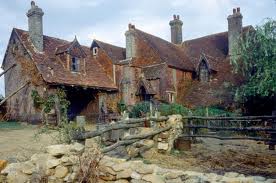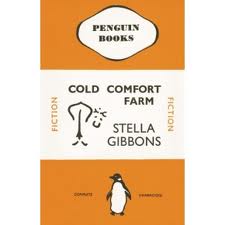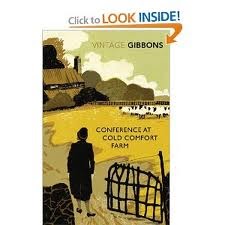Cold Comfort Farm
By Stella Gibbons
– a classic
1932
March 10, 2012
 |
| (this cover illustration is wrong is so many different ways, but is from the first edition I owned) |
 The cliche that one could not love someone who did not love (insert cultural artifact of choice) is over-used, but I am so glad that the person I chose to spend my life with loves Cold Comfort as much as I do.
The cliche that one could not love someone who did not love (insert cultural artifact of choice) is over-used, but I am so glad that the person I chose to spend my life with loves Cold Comfort as much as I do.Starkadder Mad
More on Cold Comfort – not that I am obsesssed or anything. The original novel, Stella Gibbons’s first, was published in the early 1930’s. It has a wonderful period feel – although it is set a few years in the future, and there are glimpses of how the world has changed, with video phones and passing references to a recent war, for example. Despite this the world described is comfortably Edwardian, with strong echoes of Waugh and Saki in the opening chapters on Flora and Mrs Schilling’s life in London. The move to deepest darkest Sussex, even then surely not as isolated and backward as Flora describes it, provides a contrast to the metropolitan life she has temporarily abandoned. That contrast is kept in focus by the introduction of Mr Mybug (what a great name – he is Flora’s pest, but she has a soft spot for him nonetheless) with his gloriously stupid theories about Bramwell Bronte.
Mybug “works” in the novel as a contrast to the mad rural folk around him and as a foil for Flora, but the decision to take his character and turn it into the central theme of the Cold Comfort sequel, Conference at Cold Comfort Farm, has to be one of the most bewildering a writer has ever made. The yearning to return to the Starkadders, especially when her subsequent novels had never made the same mark as her first, must have been irresistible. We all wanted to know what had happened to the farm and the cast of characters – but cared very little about the intellectuals that Mybug represented. Yet in the sequel the original cast of characters is largely forgotten or treated as marginal. We are introduced to a series of grotesque caricatures of writers and artists from Mybug’s world at whom we are invited to sneer. It is car crash writing, and how it got past an editor I will never know. It is disrespectful to the original novel, and if it has been written as fan-fic it would have been rejected by Gibbons’s estate with barely a glance.
And yet I still love it. Written in the 1950’s, with of course the world an utterly darker place, it was out of print for a long time. I originally came across it as a library copy, and pounced, desperate to know what had happened to Flora, Charles, Seth, Reuben, and the whole grisly crew. We go back to a farm transformed into a prettified National Trust venue that has been turned, utterly improbably, into a conference centre. Flora goes down to help Mr Mybug run a cultural event there for no good reason (she has a large family with Charles by now) and not much happens until the Starkadders return and all it righted. Everything funny from the original novel, including the invented language (sukebind, mollocking) has gone. But it is still Cold Comfort Farm, and we love it. We love our parents when they grow old, we love footballers who reture and get fat because of their past glories, we love the town we grew up in even though they have paved over it and erected a shopping centre – we love them despite all that, not because of it, and I still treasure the glimpses of the world Stella Gibbons unforgettably created in her original burst of genius.
THE READING BUG






No comments:
Post a Comment